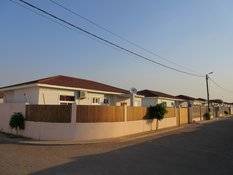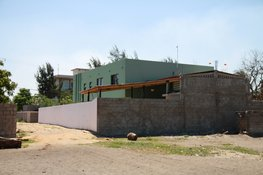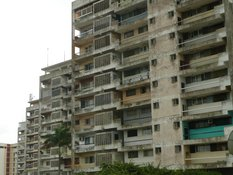Aspirations and Housing Aesthetics

This subproject explores housing aesthetics in Maputo, Mozambique, as medium rather than endpoint for subjective and collective aspirations. For many urbanites, the building or purchase of a house acquires huge investments of human and financial resources. It is an objective that many aspire towards but fewer succeed in achieving. With this project, I wish to examine how and when a house ceases to function as an objective and, instead, becomes a medium for other aspirations. It takes its point of departure in an ethnographic comparison between two of the largest urban planning initiatives to be implemented in Mozambique in recent years: the Intaka Community on the northern periphery of Maputo and the ‘New City’ (locally known as ‘China Town’) in the KaTembe peninsula across the Maputo Bay. In both instances, aesthetic values associated with the middle-class seem to be realized by groups of urbanites who do not desire typically spatially envisioned middle class status. In the Intaka Community, regular residents reconfigure the material aesthetics of the area in order to separate themselves from a collective that is based on supposed middle class values but to which they do not want to remain attached. While the design of the area was inspired by early socialist ideals of communal cohabitation, the majority of residents seek to separate themselves from the community by building 2-3 meter high cement walls. In the KaTembe peninsula, squatters have invaded the building site for the ‘New City’ and commenced building temporary shelter while laying foundations for permanent houses in order to be resettled to formally planned residential plots elsewhere. Hence, while none of the involved urbanites seem to want to remain in these areas, their aspirations of moving elsewhere are realized as an investment in the spatial aesthetics of the enclave-like communities where they are currently living.
House Interiors and the Organisation of Family Relations in Polana Caniço

This subproject explores middle class urbanism through a study of the relationship between the interior of the house and the organisation of family relations in the area of Polana Caniço. In particular, it investigates how individual and collective strategies to secure rights and privileges are related to enclaving as a socio-cultural and material orientation to the city and how these assert themselves as transformations of spatial aesthetics both in and beyond the individual house. The aim is to examine how these strategies are refracted through family dynamics. Specifically, it will look at how housing transformations oriented by notions of privacy and security are interwoven with notions of family and personhood.
The subproject is guided by two overall questions. First, to what extent are aspirations and practices revolving around the modern nuclear family ideal brought about by middle class urbanism and second, how do these interplay with notions of families and persons that are not based on the nuclear family?
For this, the investigation will seek to understand how families occupy, divide and share the space in their houses; how family relations are produced and maintained within the space of the house and the wider neighbourhood; and how they are being transformed in pace with transformations of houses and streets. It will also try and grasp how interior aesthetics, family constellation and ideological personhood come to interplay in the production of persons within households; what values, ideas and practices are related to inhabitants’ housing aspirations, and how they relate to processes of enclaving understood as an orientation towards differentiation. Last, it is also interested in delimiting where the boundary between the house and the street is and what notions of public and private and of security and danger are tied up with it.
Social Differentiation and Spatial Aesthetics

This subproject aims at examining middle class urbanism by exploring the relationship between social differentiation and spatial aesthetics. It analyses the house and the plot evolution as the relationship between the inhabiting and the aspiring and through the lens of a desired spatial and social enclave. The investigation will focus on allthe processes by which spatial and aesthetic choices acquire material efficacy and thus come to constitute specific social values, ideas of personhood and socio-cultural identity.
In many areas of the city as Zimpeto or Costa do Sol, certain forms of aesthetic differentiation and architectural details become significant in the formation of social personhood or a community identity in terms of changing values and changing perceptions. Security, privacy and desire for separation and/or differentiation are the main drivers of changing typologies and changing space interactions.
Main questions which will guide the research are: (i) Under what circumstances might social differentiation and changing ideals and lifestyle inform the spatial aesthetics of architecture and vice versa? (ii) (i) When does spatial organisation and aesthetics inform collective social values and vice versa? When and why do certain aesthetic patterns reach the level of a seemingly general aspiration, e.g. on neighbourhood or city-level?
To answer these questions, I will investigate the house time lines (aspirations) , the house in the present (use and adaptation) and as imagined future (anxieties, strategies and separation) through the observation and representation of: (a) the house construction as a process of aspiration, (b) the house a mean of social entitlement in the present as well as a mean of social disconnection, and (c) the plot space and its connections with the neighbourhood and infrastructures. Starting from this, the research will go beyond the individual level, envisaging how and when certain kinds of social differentiation influence broader processes of social and spatial differentiation and how subjective understandings of social differentiations become generalized.
Social Differentiation in Maputo Since Late Colonialism

This subproject focuses on the materialisation of social differentiation in Maputo since late colonialism. It is guided by the hypothesis that there is a concrete material form of social differentiation that distinguishes the city from comparable urban areas in sub-Saharan Africa. This material form is based on particular histories of late settler colonialism, socialism, structural adjustment and related global connections. These layers have a historical depth that continue to affect urban development in Maputo today as the effects of particular historical dynamics and values still reverberate through the materiality of the city. Thus, this subproject relates historical research to contemporary phenomena: How does social differentiation come to assert itself in particular material forms that we can observe in Maputo today?
Thereby, this subproject will provide a historical perspective on the different relations that inform our understanding of middle class urbanism. In colonial and postcolonial times, the design, planning and regularization of housing developments have been used by both the state and private developers as a means to organize the city following particular models as well as for the socialization of urbanites.
Two main questions will organise this research: First, is it possible to identify a genealogy of enclaving in the city of Maputo? Second, what is the relationship between spatial aesthetics and ideological concepts of individual or collective identities?
